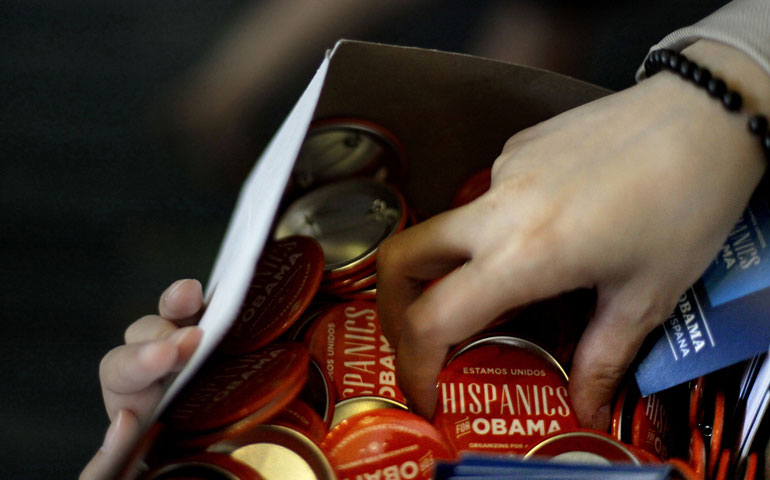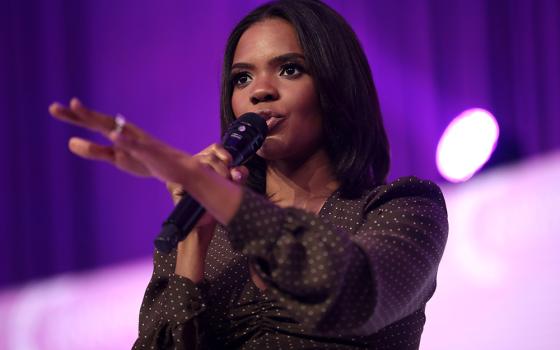
Volunteer Ginny Garahona of Washington hands out buttons before first lady Michelle Obama spoke at a Hispanic caucus Sept. 5 in Charlotte, N.C. (AP Photo/David Goldman)
Once again, Catholics will decide who will live in the White House for the next four years. It is not that Catholics constitute a majority of the electorate. Nor is it the case that there is any monolithic "Catholic vote" poised to go one way or the other. But, for a variety of reasons, Catholics will nonetheless break one way or the other in the final weeks of the race, and that will decide whether President Barack Obama or Gov. Mitt Romney wins.
The final weeks of a race are all about targeting a campaign's message and trying to get one's supporters to the polls. Most other religious demographics lean decisively one way or another. White evangelical Christians are overwhelmingly Republican, so it makes no sense for Democrats to run ads on Christian radio or leaflet at an evangelical church: For every two or three Obama supporters they remind to vote, they will also be reminding seven or eight Romney voters to turn out at the polls. Jews vote overwhelmingly Democratic, so it is unlikely the GOP will be running ads in Jewish media. (When Republicans talk about Israel, they are targeting evangelical Christian voters, who champion Israel for their own theological reasons, not Jewish voters.) Conversely, black evangelicals are the most overwhelmingly Democratic constituency in the country.
Catholics, however, mirror the general electorate. About 46 percent are reliably Democratic voters and a like number almost always support the Republican candidate. It is those voters in the center of the Catholic electorate who are genuinely up for grabs, and whom the campaigns can try and reach without fear of driving up an opponent's turnout. In 2004, Catholics broke for George W. Bush, 52 percent to 47 percent, giving him the election. In 2008, they backed Obama over Sen. John McCain, 54 percent to 46 percent. The 2008 election was not as close as the 2004 race, so the Catholic swing vote was less decisive. But all analysts are predicting that 2012 will be a very close race. In a September Pew poll, Obama was leading Romney by 54 percent to 39 percent among Catholics, besting his 2008 showing. Polling also shows that Catholics' concerns regarding the issues track closely with the electorate as a whole. While more evangelicals rate abortion or same-sex marriage as a major concern, Catholics tend to rate the economy and jobs as their principal worries.
Another reason Catholic voters will prove decisive is because they are concentrated in key swing states. White Catholics make up a substantial part of the population in Ohio, Wisconsin, Pennsylvania and Michigan, which have been leaning Democratic but are never a sure thing. In that September Pew poll, white Catholics broke for Obama by the narrower margin of 47 percent to 46 percent. Of course, religion is not the only thing that distinguishes these voters. "Catholics [in these Midwestern states] are mostly white, ethnic voters, with multiple identifications," says pollster John Zogby. "They may be members of the NRA [National Rifle Association] or members of unions." This is the problem with micro-targeting voters: They have many and varied concerns, and it is difficult for either campaign to determine which of those concerns is predominant at any given point. Of course, don't look for Democrats to be running ads in the NRA's magazine anytime soon, nor will the GOP be running ads in union literature. But expect both campaigns to invoke the language of Catholicism when visiting Dayton, Ohio, or Green Bay, Wis.: the common good, social justice, subsidiarity, dignity of life.
One campaign issue that has turned out to be a dud is religious liberty. Catholic voters are slightly more attuned to the issue than non-Catholic voters. According to a July Pew survey, only 22 percent of Catholics reported hearing "a lot" about the issue and another 42 percent said they had heard "a little." Of those who heard of it, 56 percent of Catholics shared the bishops' concern. But, according to Zogby, the issue resonated "mostly among regular church attendees who are more conservative and so were less likely to vote for Obama anyway."
The other key demographic in this election is Latinos, most of whom are Catholic. The latest Pew Hispanic Center survey, conducted from Sept. 7 through Oct. 4, has Obama leading Romney by a margin of 69 percent to 21 percent. In 2008, Obama took 67 percent of the Latino vote. Depending on how the undecided Latinos break, Obama could top 70 percent. Just as importantly, according to polling and census data, there are now 4 million more Latinos eligible to vote than there were in 2008. They could prove decisive in Virginia, Colorado, Nevada and Florida.
Latino turnout is a key concern for the Democrats. The survey indicated that 77 percent of Latinos said they were "absolutely certain" they would vote, compared to 89 percent of all registered voters. (Of course, Americans famously do not vote; in 2008, not quite 57 percent of eligible voters turned out, and that was better than previous years.) But Zogby thinks the numbers indicate a strong showing among Latinos. The fact that Obama is crushing Romney "tells me they are going to vote for him and they are going to vote, period," he said.
Of course, a lot can happen in the remaining weeks. Throughout September, Obama looked like he was heading to an easy victory. Romney's campaign suffered from a dull national convention, a campaign staff incapable of winning a 24-hour news cycle, and, most especially, the emergence of a videotape that showed Romney telling a room full of wealthy donors that 47 percent of Americans did not pay federal income tax and were unwilling to take responsibility for their lives. In all the swing states, Obama was opening up a significant lead, especially in Ohio, where most polls showed him leading by more than five points, pushing that critical state out of the "Toss Up" column at RealClearPolitics' average of polls.
By comparison, Team Obama could not put a foot wrong in September. At their national convention, former President Bill Clinton gave a speech that provided the exact narrative Obama needed. Obama's ads were crisp. Because a lot of Obama's fundraising came from small donors giving directly to his campaign and not to the national party, he was able to capitalize on a technicality in the campaign laws that allow candidates' campaigns, but not the party's, to purchase ads at a discount of as much as eight to one. Finally, Obama's field team was dominant in the swing states.
The first presidential debate on Oct. 3 changed the trajectory of the campaign narrative. Obama's listless performance and Romney's commanding one gave new enthusiasm to the GOP. But the polls have not moved hugely, and Obama's strong comeback performance in the second debate have kept them steady. Obama continues to lead in Ohio, but his margin has shrunk and the RealClearPolitics average now rates the state a tossup. Romney has opened a lead in Florida, but has not cracked the 50 percent threshold in most polls. Indeed, of all the battleground states, only two show either candidate leading by exactly 5 percentage points: Romney in North Carolina and Obama in Wisconsin. Which means that in every battleground state, both campaigns will be asking the same question: How do we win the Catholics?
[Michael Sean Winters writes about religion and politics on his Distinctly Catholic blog on the NCR website, at NCRonline.org/blogs/distinctly-catholic, first place finisher for Best Individual Blog in the 2012 the Catholic Press Association competition.]




